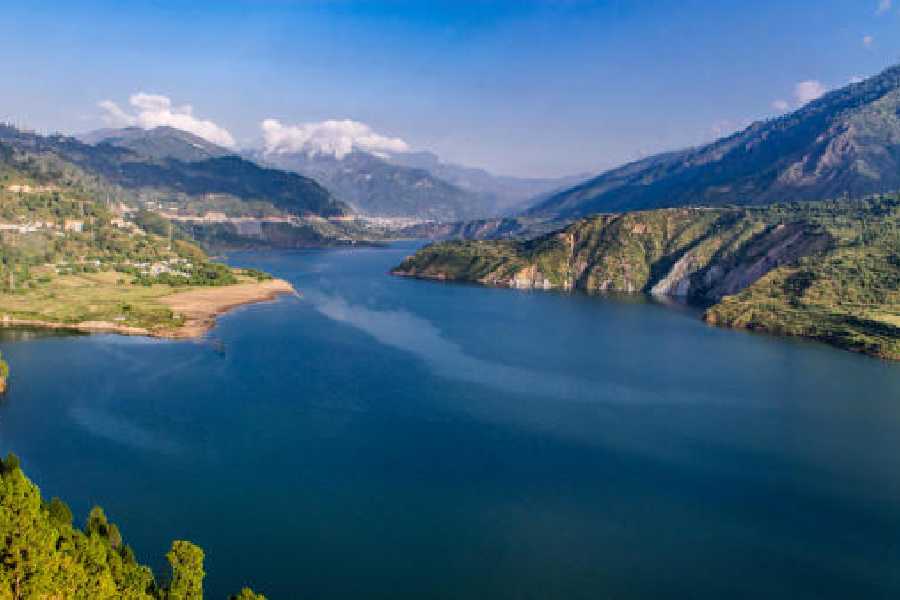Rivers in peril
Sir — A recent holiday in Uttarakhand included the usual delights of misty hills, meadows, and mountain air but it also revealed something less scenic. At the Tehri Dam, the driver pointed towards the Bhagirathi river and reminded us that an entire town, Old Tehri, lies beneath it. His home, schools, markets, and festivals are all now underwater. Textbooks call it progress but rarely explain the human cost of the submergence of entire communities. Rivers are turned into rubbish bins and construction sites, and when floods follow, people claim rivers are furious. In truth, it is years of dumping, mining, and building that have left them unable to flow. On World Rivers Day, the best gift would be to stop suffocating rivers and allow them to breathe and flow.
Yashodhara Sen,
Calcutta
Extra burden
Sir — The decision of the Donald Trump-led administration in the United States of America to impose a one-time $100,000 charge on new H-1B petitions sets a novel barrier in migration policy. This fee may deter employers from sponsoring new foreign workers, especially those perceived as higher risk for return on investment. Women, already underrepresented among Indian H-1B applicants, may suffer more: the fee could match or exceed their expected earnings. On the other hand, the fee might induce firms to scrutinise talent more rigorously and reduce casual abuse of the visa system. The key challenge is to ensure that merit shapes opportunity.
Niamul Hossain Mallick,
West Burdwan
Sir — The gendered disparity in H-1B uptake in India is real and troubling: men outnumber women roughly 3:1. With women on average earning less, a large fixed cost on visa petitions may make hiring them economically unviable. Without policy interventions, this visa cost shock risks reinforcing gender inequality in tech, especially among mid-tier and start-up employers.
T. Ramadas,
Chennai
Sir — Indian women in information technology have used H-1B visas for mobility and to expand horizons beyond domestic constraints. For many, that route offered access, exposure and upward negotiation power. The sudden hike in visa cost threatens to reverse that trajectory.
P. Suryanarayana,
Kannur
Desire decoded
Sir — The article, “Magic reels” (Sept 26), is beautifully layered. The View-Master was not the first instrument to conjure distant places. The stereoscope, popular in the nineteenth century, also transported people to imagined geographies. Owning a box of stereoscopic cards was akin to collecting stamps, each a portal to another world. In this sense, the View-Master was part of a much longer history of optical curiosity, each generation rediscovering wonder through new devices. The present obsession with Instagram is simply the latest iteration. Human longing has always been tied to images of the unseen.
Noopur Barua,
Tezpur, Assam
Sir — The nostalgia stirred by photographs of unseen places reveals how powerfully images operate on the imagination. Anemoia, as psychologists term it, is not confined to travel photographs. Paintings, postcards, and cinema once evoked similar yearning. For many, Bollywood cinema of the 1960s created a desire for Swiss landscapes. What matters is not the object but the repetition. Exposure
persuades the mind that it
already knows the scene. This is why modern travellers often describe déjà vu upon arrival in places saturated by media.
Amitava Choudhury,
Calcutta
Rough texture
Sir — The jute industry continues to employ lakhs in eastern India but faces decline from labour shortages and synthetic competition (“Spin gold, once more”, Sept 27). Bangladesh has surged ahead with exports, while Indian mills remain hamstrung by outdated technology and inconsistent procurement. Resistance to power looms and union disputes have slowed modernisation. The path forward lies
in stable procurement policies, incentives for green technologies, and aggressive global branding. Without decisive reforms, India risks surrendering its historic advantage in a fibre once celebrated as ‘golden’.
Raktim Das,
Calcutta
Sir — One rarely discussed problem when it comes to the jute industry is waste management. Jute mills generate fibre dust and effluents that compromise both workers’ health and river ecosystems. Investment in dust extraction, water treatment, and circular waste use must accompany any plan for revival. If jute is to be positioned as a sustainable material, production itself must meet sustainability benchmarks. Otherwise, claims of ecofriendliness will ring hollow. Stronger environmental regulation, paired with subsidies for mills adopting green processes, could align production realities with consumer expectations.
Aranya Sanyal,
Calcutta
Unhealthy reliance
Sir — A recent study found that people who use chatbots frequently report greater loneliness and emotional dependence. Companionship from Artificial Intelligence offers relief when human contact is scarce. Chatbots provide comfort without judgement, always on call. They serve as bridges for those isolated or grieving. On the other hand, reliance on AI risks eroding social skills. Emotional growth comes from friction, unpredictability and vulnerability, all absent in programmed empathy. Heavy users risk substituting real relationships with digital shadows. True relationships hold discomfort, challenge assumptions, share burdens. AI companionship cannot weep, mourn or offer physical presence. They risk fostering emotional dependence and unhealthy coping mechanisms.
P.K. Sharma,
Barnala, Punjab

